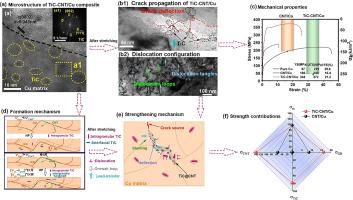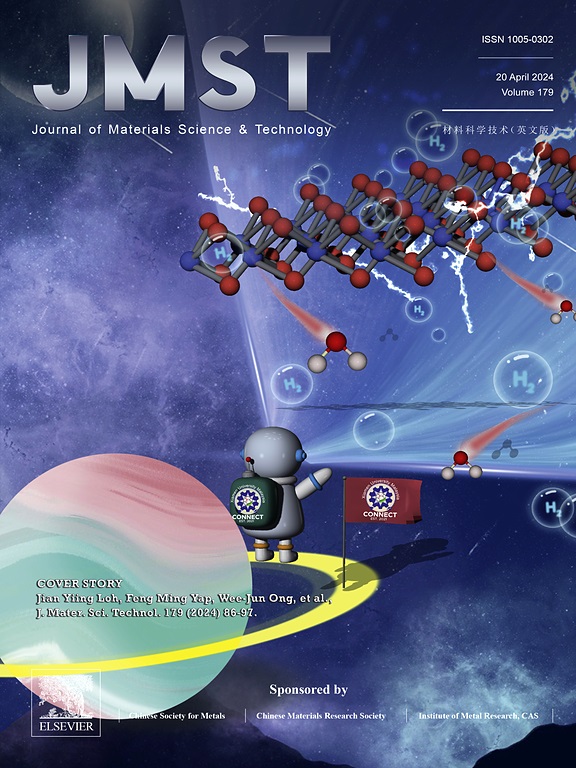在使用双纳米级 CNT 和原位粒内 TiC 增强的铜基复合材料中实现强度-电导率平衡
IF 14.3
1区 材料科学
Q1 MATERIALS SCIENCE, MULTIDISCIPLINARY
引用次数: 0
摘要
利用具有不同特征的纳米相增强金属基复合材料是利用其各自优势,实现复合材料优异性能的有效策略。在本研究中,采用分子水平混合(MLM)、段球磨(SBM)和原位固相反应相结合的方法制备了TiC修饰CNT (TiC@CNT)和原位纳米级TiC颗粒增强的Cu基复合材料(TiC-CNT/Cu)。HRTEM结果表明,界面TiC在CNT(即CNT(0002)//TiC(200)表面外延生长,TiC与Cu基体之间形成半相干界面,可有效增强界面结合强度,优化CNT的负载传递效率。独立的原位TiC纳米颗粒通过晶界迁移进入晶粒内部,充分利用Orowan强化机制,显著提高了复合材料的应变硬化能力和强度。此外,界面结合强度的增强还能有效抑制裂纹的萌生和扩展,从而提高复合材料的断裂韧性。当碳纳米管体积百分比为1.2时,TiC-CNT/Cu复合材料的抗拉强度达到372 MPa,强化效率达到270,同时保持了21.2%的显著延展性。此外,TiC-CNT/Cu复合材料的冲击韧性比CNT/Cu复合材料提高了70.7%,达到了251 kJ/m²的令人印象深刻的值,从而表现出优异的断裂韧性。充分利用不同纳米相的协同强化效应是提高复合材料综合性能的有效途径。本文章由计算机程序翻译,如有差异,请以英文原文为准。

Achieving strength–ductility balance in Cu matrix composite reinforced with double nanophase of CNT and intragranular in-situ TiC
Reinforcing metal matrix composites (MMCs) with nanophases of distinct characteristics is an effective strategy for utilizing their individual advantages and achieving superior properties of the composite. In this study, a combination of molecular level mixing (MLM), segment ball milling (SBM), and in-situ solid-phase reaction was employed to fabricate Cu matrix composites (TiC-CNT/Cu) reinforced with TiC decorated CNT (TiC@CNT) and in-situ nanoscale TiC particles. The HRTEM results revealed the epitaxial growth of interfacial TiC on the surface of CNT (i.e., CNT(0002)//TiC(200), and the formation of a semi-coherent interface between TiC and Cu matrix, which can effectively enhance the interfacial bonding strength and optimize load transfer efficiency of CNT. The independent in-situ TiC nanoparticles got into the grain interior through grain boundary migration, thereby significantly enhancing both strain hardening capacity and strength of the composite by fully utilizing the Orowan strengthening mechanism. Moreover, the enhanced bonding strength of the interface can also effectively suppress crack initiation and propagation, thereby improving the fracture toughness of the composite. The TiC-CNT/Cu composite with 1.2 vol.% CNT exhibited a tensile strength of 372 MPa, achieving a super high strengthening efficiency of 270, while simultaneously maintaining a remarkable ductility of 21.2%. Furthermore, the impact toughness of the TiC-CNT/Cu composite exhibited a significant enhancement of 70.7% compared to that of the CNT/Cu composite, reaching an impressive value of 251 kJ/m², thereby demonstrating exceptional fracture toughness. Fully exploiting the synergistic strengthening effect of different nanophases can be an effective way to improve the comprehensive properties of MMCs.
求助全文
通过发布文献求助,成功后即可免费获取论文全文。
去求助
来源期刊

Journal of Materials Science & Technology
工程技术-材料科学:综合
CiteScore
20.00
自引率
11.00%
发文量
995
审稿时长
13 days
期刊介绍:
Journal of Materials Science & Technology strives to promote global collaboration in the field of materials science and technology. It primarily publishes original research papers, invited review articles, letters, research notes, and summaries of scientific achievements. The journal covers a wide range of materials science and technology topics, including metallic materials, inorganic nonmetallic materials, and composite materials.
 求助内容:
求助内容: 应助结果提醒方式:
应助结果提醒方式:


